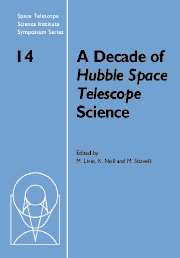Book contents
- Frontmatter
- Contents
- Participants
- Preface
- HST studies of Mars
- HST images of Jupiter's UV aurora
- Star formation
- SN1987A: The birth of a supernova remnant
- Globular clusters: The view from HST
- Ultraviolet absorption line studies of the Galactic interstellar medium with the Goddard High Resolution Spectrograph
- HST's view of the center of the Milky Way galaxy
- Stellar populations in dwarf galaxies: A review of the contribution of HST to our understanding of the nearby universe
- The formation of star clusters
- Starburst galaxies observed with the Hubble Space Telescope
- Supermassive black holes
- The HST Key Project to measure the Hubble Constant
- H0 from Type Ia supernovae
- Strong gravitational lensing: Cosmology from angles and redshifts
Preface
Published online by Cambridge University Press: 13 August 2009
- Frontmatter
- Contents
- Participants
- Preface
- HST studies of Mars
- HST images of Jupiter's UV aurora
- Star formation
- SN1987A: The birth of a supernova remnant
- Globular clusters: The view from HST
- Ultraviolet absorption line studies of the Galactic interstellar medium with the Goddard High Resolution Spectrograph
- HST's view of the center of the Milky Way galaxy
- Stellar populations in dwarf galaxies: A review of the contribution of HST to our understanding of the nearby universe
- The formation of star clusters
- Starburst galaxies observed with the Hubble Space Telescope
- Supermassive black holes
- The HST Key Project to measure the Hubble Constant
- H0 from Type Ia supernovae
- Strong gravitational lensing: Cosmology from angles and redshifts
Summary
The Space Telescope Science Institute Symposium on “A Decade of HST Science” took place during 11–14 April 2000.
There is no doubt that the Hubble Space Telescope (HST) in its first decade of operation has had a profound impact on astronomical research. But HST did much more than that. It literally brought a glimpse of the wonders of the universe into millions of homes worldwide, thereby inspiring an unprecedented public curiosity and interest in science.
HST has seen farther and sharper than any optical/UV/IR telescope before it. Unlike astronomical experiments that were dedicated to a single, very specific goal, HST's achievements are generally not of the type of singular discoveries. More often, HST has taken what were existing hints and suspicions from ground-based observations and has turned them into certainty.
In other cases, the level of detail that HST has provided forced theorists to re-think previous broad-brush models, and to construct new ones that would be consistent with the superior emerging data. In a few instances, the availability of HST's razor-sharp vision at critical events provided unique insights into individual phenomena.
These proceedings represent a part of the invited talks that were presented at the symposium, in order of presentation. We thank the contributing authors for preparing their papers.
- Type
- Chapter
- Information
- Publisher: Cambridge University PressPrint publication year: 2003

